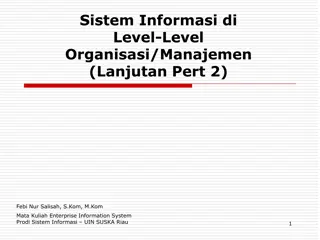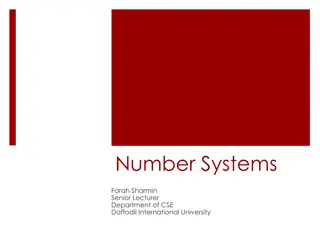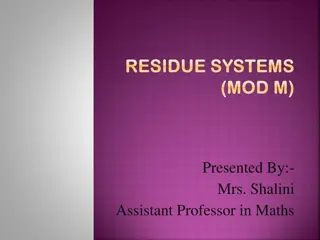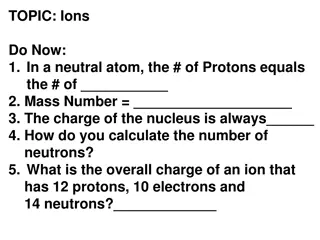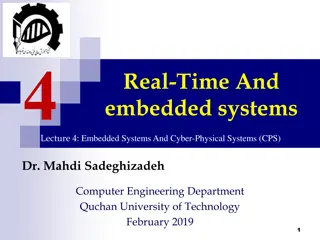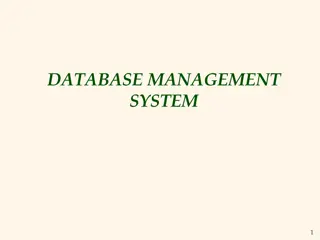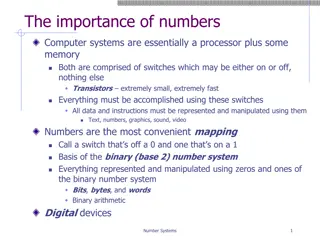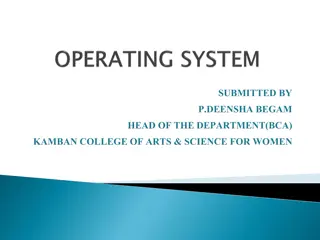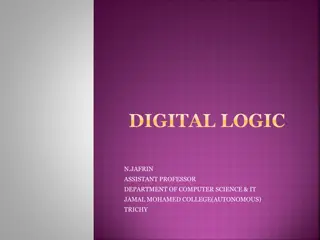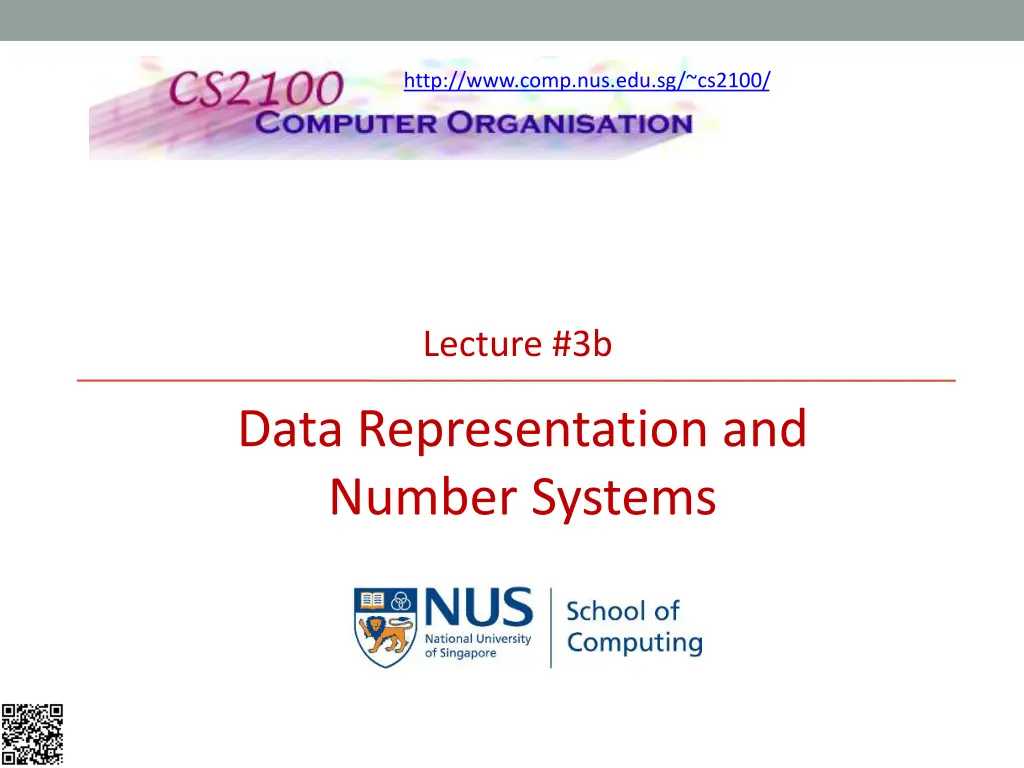
Understanding Data Representation and Number Systems in Computer Science
Explore the fundamentals of data representation and number systems in computer science, including ASCII code, integer and character interchangeability in C, and practical examples. Dive into past-year exam questions to enhance your understanding. Learn about negative numbers and their representation in computer systems.
Download Presentation

Please find below an Image/Link to download the presentation.
The content on the website is provided AS IS for your information and personal use only. It may not be sold, licensed, or shared on other websites without obtaining consent from the author. If you encounter any issues during the download, it is possible that the publisher has removed the file from their server.
You are allowed to download the files provided on this website for personal or commercial use, subject to the condition that they are used lawfully. All files are the property of their respective owners.
The content on the website is provided AS IS for your information and personal use only. It may not be sold, licensed, or shared on other websites without obtaining consent from the author.
E N D
Presentation Transcript
http://www.comp.nus.edu.sg/~cs2100/ Lecture #3b Data Representation and Number Systems
Questions? IMPORTANT: DO NOT SCAN THE QR CODE IN THE VIDEO RECORDINGS. THEY NO LONGER WORK Ask at https://sets.netlify.app/module/676ca3a07d7f5ffc1741dc65 OR Scan and ask your questions here! (May be obscured in some slides)
Lecture #3: Data Representation and Number Systems 3 9. ASCII Code (1/3) ASCII code and Unicode are used to represent characters ( a , C , ? , \0 , etc.) ASCII American Standard Code for Information Interchange 7 bits, plus 1 parity bit (odd or even parity) Character 0 1 . . . 9 : A B . . . Z [ \ ASCII Code 0110000 0110001 . . . 0111001 0111010 1000001 1000010 . . . 1011010 1011011 1011100
Lecture #3: Data Representation and Number Systems 4 9. ASCII Code (2/3) A : 1000001 (or 6510) ASCII table MSBs 011 0 1 2 3 4 5 6 7 8 9 : ; < = > ? LSBs 0000 0001 0010 0011 0100 0101 0110 0111 1000 1001 1010 1011 1100 1101 1110 1111 000 NUL SOH STX ETX EOT ENQ NAK ACK BEL BS HT LF VT FF CR O SI 001 DLE DC1 DC2 DC3 DC4 010 SP ! # $ % & ( ) * + , - . / 100 @ A B C D E F G H I J K L M N O 101 P Q R S T U V W X Y Z [ \ ] ^ _ 110 ` a b c d e f g h i j k l m n o 111 p q r s t u v w x y z { | } ~ DEL SYN ETB CAN EM SUB ESC FS GS RS US
Lecture #3: Data Representation and Number Systems 5 9. ASCII Code (3/3) (Slide 5 in lecture 3a) As an int , it is 70 01000110 As a char , it is F Integers (0 to 127) and characters are somewhat interchangeable in C CharAndInt.c int num = 65; char ch = 'F'; num (in %d) = 65 num (in %c) = A printf("num (in %%d) = %d\n", num); printf("num (in %%c) = %c\n", num); printf("\n"); ch (in %c) = F ch (in %d) = 70 printf("ch (in %%c) = %c\n", ch); printf("ch (in %%d) = %d\n", ch);
Lecture #3: Data Representation and Number Systems 6 Past-Year s Exam Question! PastYearQn.c int i, n = 2147483640; for (i=1; i<=10; i++) { n = n + 1; } printf("n = %d\n", n); What is the output of the above code when run on sunfire? Is it 2147483650?
Lecture #3: Data Representation and Number Systems 7 10. Negative Numbers Unsigned numbers: only non-negative values Signed numbers: include all values (positive and negative) There are 3 common representations for signed binary numbers: Sign-and-Magnitude 1s Complement 2s Complement
Lecture #3: Data Representation and Number Systems 8 10.1 Sign-and-Magnitude (1/3) The sign is represented by a sign bit 0 for + 1 for - Eg: a 1-bit sign and 7-bit magnitude format. magnitude sign 00110100 +1101002 = +5210 10010011 -100112 = -1910
Lecture #3: Data Representation and Number Systems 9 10.1 Sign-and-Magnitude (2/3) Largest value: Smallest value: Zeros: Range (for 8-bit): -12710 to +12710 Question: For an n-bit sign-and-magnitude representation, what is the range of values that can be represented? 01111111 = +12710 11111111 = -12710 00000000 = +010 10000000 = -010
Lecture #3: Data Representation and Number Systems 10 10.1 Sign-and-Magnitude (3/3) To negate a number, just invert the sign bit. Examples: How to negate 00100001sm (decimal 33)? Answer: 10100001sm (decimal -33) How to negate 10000101sm (decimal -5)? Answer: 00000101sm (decimal +5)
Lecture #3: Data Representation and Number Systems 11 10.2 1s Complement (1/3) Given a number x which can be expressed as an n-bit binary number, its negated value can be obtained in 1s-complement representation using: -x = 2n x 1 Example: With an 8-bit number 00001100 (or 1210), its negated value expressed in 1s-complement is: -000011002 = 28 12 1 (calculation done in decimal) = 243 = 111100111s (This means that -1210 is written as 11110011 in 1s- complement representation.)
Lecture #3: Data Representation and Number Systems 12 10.2 1s Complement (2/3) Technique to negate a value: invert all the bits. Largest value: 01111111 = +12710 Smallest value: 10000000 = -12710 Zeros: 00000000 = +010 11111111 = -010 Range (for 8 bits): -12710 to +12710 Range (for n bits): -(2n-1 1) to 2n-1 1 The most significant bit (MSB) still represents the sign: 0 for positive, 1 for negative.
Lecture #3: Data Representation and Number Systems 13 10.2 1s Complement (3/3) Examples (assuming 8-bit): (14)10 = (00001110)2 = (00001110)1s -(14)10 = -(00001110)2 = (11110001)1s -(80)10 = -( ? )2 = ( ? )1s
Lecture #3: Data Representation and Number Systems 14 10.3 2s Complement (1/3) Given a number x which can be expressed as an n-bit binary number, its negated value can be obtained in 2s-complement representation using: -x = 2n x Example: With an 8-bit number 00001100 (or 1210), its negated value expressed in 2s-complement is: -000011002 = 28 12 (calculation done in decimal) = 244 = 111101002s (This means that -1210 is written as 11110100 in 2s- complement representation.)
Lecture #3: Data Representation and Number Systems 15 10.3 2s Complement (2/3) Technique to negate a value: invert all the bits, then add 1. Largest value: 01111111 = +12710 Smallest value: 10000000 = -12810 Zero: 00000000 = +010 Range (for 8 bits): -12810 to +12710 Range (for n bits): -2n-1 to 2n-1 1 The most significant bit (MSB) still represents the sign: 0 for positive, 1 for negative.
Lecture #3: Data Representation and Number Systems 16 10.3 2s Complement (3/3) Examples (assuming 8-bit): (14)10 = (00001110)2 = (00001110)2s -(14)10 = -(00001110)2 = (11110010)2s -(80)10 = -( ? )2 = ( ? )2s Compare with slide 13. 1s complement: (14)10 = (00001110)2 = (00001110)1s -(14)10 = -(00001110)2 = (11110001)1s
Lecture #3: Data Representation and Number Systems 17 Important! 10.4 Comparisons 4-bit system Positive values Negative values Value Sign-and- Magnitude 1000 1001 1010 1011 1100 1101 1110 1111 - 1s 2s Value Sign-and- Magnitude 0111 0110 0101 0100 0011 0010 0001 0000 1s 2s Comp. 1111 1110 1101 1100 1011 1010 1001 1000 - Comp. - 1111 1110 1101 1100 1011 1010 1001 1000 Comp. 0111 0110 0101 0100 0011 0010 0001 0000 Comp. 0111 0110 0101 0100 0011 0010 0001 0000 -0 -1 -2 -3 -4 -5 -6 -7 -8 +7 +6 +5 +4 +3 +2 +1 +0
Lecture #3: Data Representation and Number Systems 18 Past-Year s Exam Question! (Answer) PastYearQn.c int i, n = 2147483640; for (i=1; i<=10; i++) { n = n + 1; } printf("n = %d\n", n); What is the output of the above code when run on sunfire? Is it 2147483650? 1st iteration: n = 2147483641 7th iteration: n = 2147483647 01111 . 1111111111 int type in sunfire takes up 4 bytes (32 bits) and uses 2s complement Largest positive integer = 231 1 = 2147483647 + 1 10000 .0000000000 8th iteration: n = -2147483648 9th iteration: n = -2147483647 10th iteration: n = -2147483646
Lecture #3: Data Representation and Number Systems 19 10.5 Complement on Fractions We can extend the idea of complement on fractions. Examples: Negate 0101.01 in 1s-complement Answer: 1010.10 Negate 111000.101 in 1s-complement Answer: 000111.010 Negate 0101.01 in 2s-complement Answer: 1010.11
Lecture #2: Overview of C Programming 1 - 20 Quiz Please complete the CS2100 C Number Systems Quiz 2 in Canvas. Access via the Quizzes tool in the left toolbar and select the quiz on the right side of the screen.
Lecture #3: Data Representation and Number Systems 21 End of File


